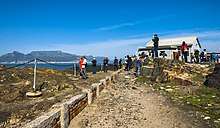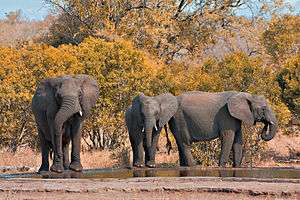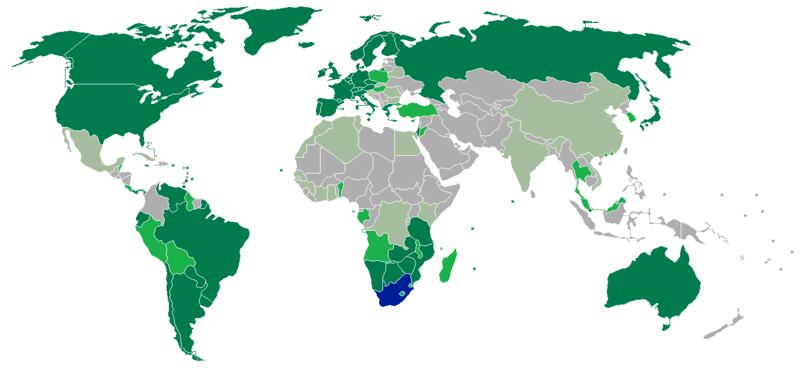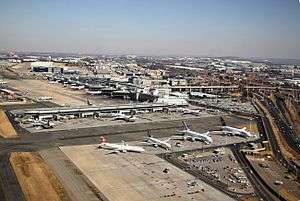Tourism in South Africa

South Africa is a tourist destination and the industry accounts for a substantial amount of the country's revenue. According to the World Travel & Tourism Council, the tourism industry directly contributed ZAR 102 billion to South African GDP in 2012, and supports 10.3% of jobs in the country.[1]
South Africa offers both domestic and international tourists a wide variety of options, among others the picturesque natural landscape and game reserves, diverse cultural heritage and highly regarded wines. Some of the most popular destinations include several national parks, such as the expansive Kruger National Park in the north of the country, the coastlines and beaches of the KwaZulu-Natal and Western Cape provinces, and the major cities like Cape Town, Johannesburg and Durban.
According to Statistics South Africa's latest Tourism and Migration Survey, almost 3,5 million travellers passed through the country's ports of entry in August 2017[2]. The top five overseas countries with the largest number of tourists visiting South Africa were the USA, UK, Germany, the Netherlands and France. Most of the tourists arriving in South Africa from elsewhere in Africa came from SADC countries. Zimbabwe tops the list at 31%, followed by Lesotho, Mozambique, Swaziland and Botswana. In addition, Nigeria was the country of origin for nearly 30% of tourists arriving in South Africa.[3]
Attractions
Biodiversity and ecotourism

South Africa is ranked sixth out of the world's seventeen megadiverse countries[4] and is home to a large variety of animal life. Among the large mammals found in the northern bushveld include lions, leopards, cheetahs, white rhinoceroses, blue wildebeest, kudus, impalas, hyenas, hippopotamuses and giraffes. A significant extent of the bushveld exists in the north-east, including the Kruger National Park, one of the largest game reserves in Africa, and the Sabi Sand Game Reserve. The Kruger National Park, established in 1926, is one of the most visited national parks in the country, with a total of 1 659 793 visitors in the 2014/15 period.[5]
The country is also particularly rich in plant diversity, with a wide variety of biomes found across the country. These include the grasslands in the Highveld, the succulent Karoo in central South Africa, and the endemic fynbos biome, constituting the majority of the area and plant life in the Cape floristic region of the Western Cape. This rare vegetation is protected as part of the Table Mountain National Park (which also includes the iconic flat-topped Table Mountain), which was the most-visited national park in South Africa in 2014/15, with a total of 2 677 767 visitors.[5]
Ecotourism
It is difficult to know if there is regulation of the term 'ecotourism' as well as what a foundation/association/company needs to do to fall into the category of 'eco-travel'. However, there is a non-profit association that represents the private sector of the "incoming tourism industry in South Africa" (which is a large group) called the South African Tourism Services Association (SATSA), they are "dedicated to providing and maintaining the highest possible standards in the tourism industry within South Africa." (SATSA, 2007) SATSA is focused on the accountability, integrity, and quality control of the tourism industry in South Africa as well as with the companies and associations they are connected to. In addition to SATSA, the website responsibletravel.com partnered with The Metro, World Travel Market and Travel Trade Gazette Magazine have established the World Responsible Tourism Awards. The goal of the award is to "recognize individuals, companies and organizations in the travel industry that are making a significant commitment to the culture and economies of local communities and are providing a positive contribution to biodiversity conservation." (www.worldresponsibletourismawards.com, 2001)
Cultural attractions
In addition to its numerous natural attractions, South Africa also boasts numerous attractions of cultural significance. These include the fossil-bearing caves forming part of the Cradle of Humankind in Gauteng, the ruins of the Kingdom of Mapungubwe in northern Limpopo, the wine routes of the Western Cape, and various historical sites in the cities of Cape Town and Johannesburg (such as Robben Island, the Castle of Good Hope and Soweto township).
UNESCO World Heritage Sites
Eight South African sites are inscribed on the UNESCO World Heritage List, including the iSimangaliso Wetland Park and uKhahlamba Drakensberg Park in KwaZulu-Natal.

Visa policy

Visitors to South Africa must obtain a visa from one of the South African diplomatic missions unless they come from one of the visa exempt countries, in which case they get what is called a "Port of Entry Visa". Visitors who require a visa must apply in person and provide biometric data.[7]
Statistics

In 2014, a total of 9 549 236 tourists (overnight visitors) entered South Africa, indicating an increase of 0,1% from the 9 536 568 tourists recorded in 2013. The highest number of arrivals was recorded in January of that year, while the lowest number was recorded in June. A vast majority (76,2%) of tourists arriving in the country were residents of SADC countries, 1.9% were from 'other' African countries and 23.6% were residents of countries overseas.
Foreign arrivals by year
| Foreign traveller arrivals (2000-2015)[8] | |||
|---|---|---|---|
| Year | Foreign arrivals
(in thousands) |
Year | Foreign Arrivals
(in thousands) |
| 2000 | 6 001 000 | 2008 | 9 729 000 |
| 2001 | 5 908 000 | 2009 | 10 098 000 |
| 2002 | 6 550 000 | 2010 | 11 575 000 |
| 2003 | 6 640 000 | 2011 | 12 496 000 |
| 2004 | 6 815 000 | 2012 | 13 796 000 |
| 2005 | 7 518 000 | 2013 | 15 155 000 |
| 2006 | 8 509 000 | 2014 | 15 092 000 |
| 2007 | 9 208 000 | 2015 | 15 052 000 |
Tourist arrivals by country
| Tourist arrivals of Top 10 SADC countries[9] | Tourist arrivals of Top 10 overseas countries[9] | ||||||
|---|---|---|---|---|---|---|---|
| Ranking | Country
of origin |
Visitor arrivals
2015 |
% Total
arrivals |
Ranking | Country
of origin |
Visitor arrivals
2015 |
% Total
arrivals |
| 1 | 1 900 791 | 28.9 | 1 | 407 486 | 19.0 | ||
| 2 | 1 394 913 | 21.2 | 2 | 297 226 | 13.9 | ||
| 3 | 1 200 335 | 18.3 | 3 | 256 646 | 12.0 | ||
| 4 | 838 006 | 12.7 | 4 | 128 438 | 6.0 | ||
| 5 | 593 514 | 9.0 | 5 | 121 883 | 5.7 | ||
| 6 | 212 514 | 3.2 | 6 | 99 205 | 4.6 | ||
| 7 | 161 259 | 2.5 | 7 | 84 691 | 3.9 | ||
| 8 | 135 260 | 2.1 | 8 | 78 385 | 3.7 | ||
| 9 | 48 416 | 0.7 | 9 | 56 224 | 2.6 | ||
| 10 | 35 817 | 0.5 | 10 | 52 377 | 2.4 | ||
References
- ↑ "Travel & Tourism Economic Impact 2013 South Africa" (PDF). WTTC. March 2013. Archived from the original (PDF) on 9 March 2014. Retrieved 20 November 2013.
- ↑ "Tourism and Migration, August 2017". Statistics South Africa. 25 October 2017. Retrieved 24 November 2017.
- ↑ "3,5 million travellers to South Africa". Statistics South Africa. 25 October 2017. Retrieved 24 November 2017.
- ↑ "Biodiversity of the world by countries". Institutoaqualung.com.br. Archived from the original on 2010-11-01. Retrieved 30 May 2010.
- 1 2 "SANParks Annual Report - 2014/15" (PDF).
- ↑ "South Africa - Properties inscribed on the World Heritage List". UNESCO. Retrieved 2 June 2011.
- ↑ New visa rules will hurt tourism: DA
- ↑ Tourism 2015. statssa.gov.za (4 April 2016)
- 1 2 "Statistics SA: Tourism 2015" (PDF).
External links
| Wikivoyage has a travel guide for South Africa. |